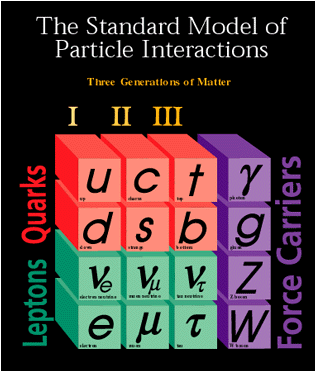 |
| The world as we know it ... |
Consider "Five Independent Signs Of New Physics In The Universe." If physics interests you, all five issues are worth a look -- but the item of most interest to me is dark matter. Bottom line: the behavior of such large objects as galaxies and galactic clusters doesn't fit with our understanding of gravity absent lots of unseen matter. If we do understand gravity -- the heart of general relativity -- then there must be lots of dark matter out there. But the standard model has no place for a dark-matter particle(s), and no search for dark-matter particles -- or for any particle physics beyond the standard model(*) -- has yet borne fruit.
(*) For example, super-symmetry or string theory.
What if we don't understand gravity? What if, at large enough scales, gravity behaves differently than within the piddling confines of our little solar system? Such "modified Newtonian Dynamics" (aka, MOND) theories of gravity underpin the notion that we don't find dark-matter particles because they don't exist. See "New theory of gravity might explain dark matter."
(And in a related side note, "Vera Rubin Didn't Discover Dark Matter: She wasn't even convinced it existed.)
Mainstream cosmology, which draws upon general relativity, also has its share of issues. For one: the derived age of the universe (estimated by projecting backward from the universe's observed expansion) doesn't seem to allow for presently remote regions to have interacted. If they didn't interact, and random fluctuations in the primordial aftermath of the Big Bang eventually led to such structures as galactic clusters, why does the universe appear pretty much the same when looking in all directions?
| The universe as we know it ... |
Cosmologists invoke way-faster-than-light "inflation" immediately after the Big Bang to explain the comparative homogeneity of the observed universe. (How can anything be faster than light? Relativity precludes matter traveling through space-time faster than light, but not an FTL expansion of space-time itself.) Basically, this theory has it, a tiny (hence plausibly homogenized) region of the young universe inflated to became the observable universe.
But there have long been other theories, the most intriguing (to this blogger, anyway) of which is "variable speed of light." To wit: the early universe -- whose physical conditions were much different than anything we can observe or reproduce -- might have supported a different speed of light than what we now measure. A (much) faster speed of light early on would have permitted influence across the young universe without recourse to inflation. See "Theory that challenges Einstein's physics could soon be put to the test."
Is the mainstream theory of gravity in need of a correction for cosmic distances? Did the speed of light change since the early universe? Unknown -- but if either is found to be the case, modern physics will be shaken to its core.

































No comments:
Post a Comment